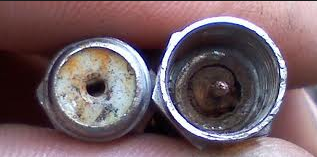Passive Inter-modulation (PIM)
Passive Inter-modulation (PIM) is the generation of interfering signals caused by non-linearities that occurs in passive components such as antennas, cables, connectors, or duplexers with two or more high-power input signals. Two signals mix together (amplitude modulation) to produce sum and difference signals and products within the same band, causing distortion.
PIM is becoming a critical parameter recently due to installation of new technologies in wireless communication industries such as higher RF transmission power, multi-band operation with a shared common antenna, or wider bandwidth signals with higher probability of PIM in the receiver band.
PIM shows up as a set of unwanted signals created by the mixing of two or more strong RF signals in a nonlinear device, suppose F1 and F2 are the two RF signal entering a passive device such as RF connector, then several different order products are generated that are harmful for the system performance.
This pair of formulas can predict PIM frequencies for two carriers:
F1 and F2 are carrier frequencies and the constants n and m are positive integers.
When referring to PIM products, the sum of n + m is called the product order, so if m is 2 and n is 1, the result is referred to as a third-order product (Figure 1). Typically, the third-order product is the strongest, causing the most harm, followed by the fifth- and seventh-order products. Since PIM amplitude becomes lower as the order increases, higher order products typically are not strong enough to cause direct frequency problems, but usually assist in raising the adjacent noise floor.
Once this raised noise floor crosses into the Rx band, it then has an open door (and sometimes gain via a LNA) into the BTS, which degrades the receiver side performance such as sensitivity etc.
Causes of PIM
PIM is caused by rust, corrosion, loose connections, dirt, oxidation, and any contamination of these factors. Even nearby metal objects such as guy wires and anchors, roof flashings, and pipes can cause PIM. The result is a diode-like nonlinearity that makes an excellent mixer. As non-linearity increases, so does the amplitude of the PIM signals.
PIM tends to increase as components age. Older systems are particularly susceptible. Environments where there are wide temperature variations, salt air or polluted air, or excessive vibrations exacerbate PIM.
So next time you use a RF passive component such as Rf cable, adaptor, connector etc., check the PIM levels of the same.






